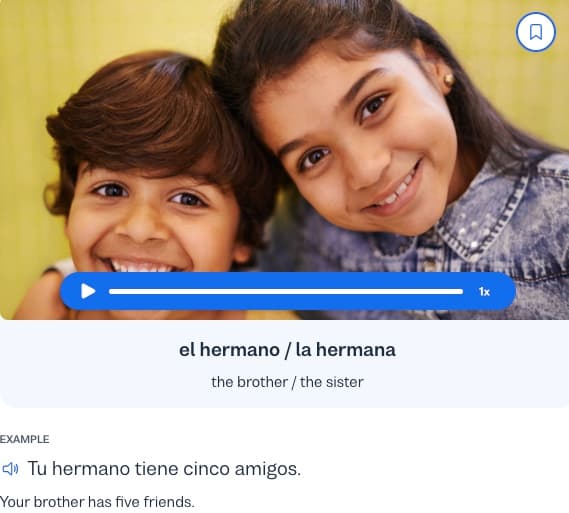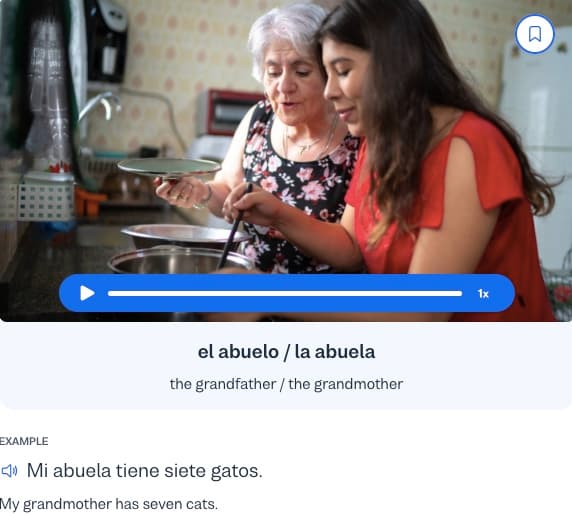I want to learn...
When studying Spanish, one of the first lessons you will come across is definite and indefinite articles. It is essential to understand the use of definite articles, as they play a crucial role in specifying and identifying nouns in the language.
In English, we only use one definite article“the”when we speak, but in Spanish, however, there are four definite articles you have to know. In comparison, it might seem like a lot, but you will pick them up quickly! In this post, we will learn what definite articles are and how to use them.
What are the definite articles in Spanish?
Articles are identifying words for a noun; we use these words in reference to living things, places, and objects, including essential Spanish nouns you need to know. Our focus today will be on Spanish definite articles.
In Spanish, there are four definite articles. A rule of thumb when learning definite and indefinite articles is that each has to agree in gender and number with the noun they precede, which can be feminine or masculine and singular or plural:
Table of Spanish definite articles
| Gender | Singular | Plural |
|---|---|---|
| Masculine | El | Los |
| Feminine | La | Las |
Examples of the Spanish definite articles
(Feminine/singular) - La chica (The girl)
(Feminine/plural) - Las amigas (The friends)
(Masculine/singular) - El chico (The boy)
(Masculine/plural) - Los jugadores (The players)
When a feminine noun starts with a stressed 'a' or 'ha' sound, the masculine article 'el' is used to sound smoother and avoid repeating the same sound twice in a row. However, if the noun is immediately preceded by an adjective, this exception doesn’t apply.
For example:
El agua (The water) - Instead of "la agua."
El alma (The soul) - Instead of "la alma."
El hacha (The axe) - Instead of "la hacha."
“El agua fresca” (The fresh water) but “La fresca agua”.
“El arma peligrosa” (The dangerous weapon) but “La peligrosa arma”.
Note that in Spanish, adjectives can be placed either before or after the noun they modify, but the most common and standard position for adjectives is after the noun. Adjectives are placed before the noun to convey a specific emphasis or nuance.
Using definite articles: Spanish vs. English
We hope that you now have a better understanding of Spanish definite articles than when you started reading this article. Our aim is to help you achieve your language learning goals, and knowing the definite articles is one of them.
In Spanish, the definite article (el, la, los, las) is used in some situations where it is not used in English.
Here are some common cases where the definite article is used in Spanish but not in English:
1. Before titles and occupations
In Spanish, unlike English, we use the definite article to indicate a person's title. For example:
La Dra. Adams me hace las recetas. (Dr. Adams fills my prescriptions.)
El profesor Gama enseña finanzas. (Professor Gama teaches finance.)
La señora Ortega es mi vecina. (Mrs. Ortega is my neighbor.)
2. Before the time
Unlike in English, when telling the time in Spanish, we need to use the definite article. Note that the hours are feminine in Spanish, so you’ll use the definite articles “la” (la una - one o’clock) and “las”.
For example:
Son las tres de la tarde. (It is three in the afternoon.) -
La película empieza a las siete. (The movie starts at seven.)
Voy a salir de mi casa a la una. (I am going to leave my house at one o’clock.)
3. Before the days of the week
Unlike in English, where we use prepositions before saying a day of the week, in Spanish, we use masculine definite articles. The days of the week are always masculine, therefore, you will invariably use el and los.
a. When discussing a specific day, you use el:
Tengo previsto llegar el miércoles. (I plan to get there on Wednesday.)
¿Estarás en la cena familiar el domingo? (Will you be at the family dinner on Sunday?) -
b. When discussing something that occurs on a regular basis, you use los:
Voy a la clase de baile los lunes. (I go to dance class on Mondays.) -
Cenamos juntos en familia todos los domingos. (We have a family dinner together every Sunday.)
4. Before seasons
In Spanish, the definite article is used before the seasons, whereas in English, we omit it. For example:
El invierno es frío en esta región. (Winter is cold in this region.)
El verano en esta ciudad puede ser muy caluroso. (Summer in this city can be very hot.)
El otoño es mi estación favorita. (Autumn is my favorite season.)
La primavera será más cálida. (Spring will be warmer).
5. Before body parts
In Spanish, the definite article is often used before certain body parts to indicate possession or to talk about a specific body part. For example:
Me duele la cabeza. (My head hurts.)
Le dolían los ojos después de tanto leer. (His/her eyes hurt after reading so much.)
Necesito lavarme las manos. (I need to wash my hands.)
6. Before meals
In Spanish, the definite article is often used before meals when talking about them in a general sense or as a regular activity. For example:
El desayuno es importante para empezar el día con energía. (Breakfast is important to start the day with energy.)
La comida se sirve a las dos. (Lunch is served at two o’clock).
7. Talking about things you like and don’t like
Unlike in English, in Spanish we use the definite articles when indicating things we like or dislike. For example:
Prefiero la música clásica. (I prefer classical music.).
A él le gusta el fútbol. (He likes football.)
Odian las montañas rusas. (They hate roller coasters.)
A ellos no les gusta el queso. (They don’t like cheese.)
8. Generalisations
Although in English the definite article is omitted when talking about things in general, in Spanish it is obligatory. For example:
Los gatos son adorables. (Cats are adorable.)
Las limonadas son tan refrescantes. (Lemonades are so refreshing.)
Me gusta el té. (I like tea.)
Making heads or tails of definite articles in Spanish
In conclusion, mastering Spanish definite articles is essential for effective language learning.
Understanding their role in specifying nouns, dealing with exceptions and placing them correctly in sentences will greatly improve your Spanish and allow you to communicate more clearly and confidently.
If you have started lessons on Busuu or read this post more than once, you are well on your way to grasping this concept and knowing exactly which article in Spanish to use and when.
Newlanguages


